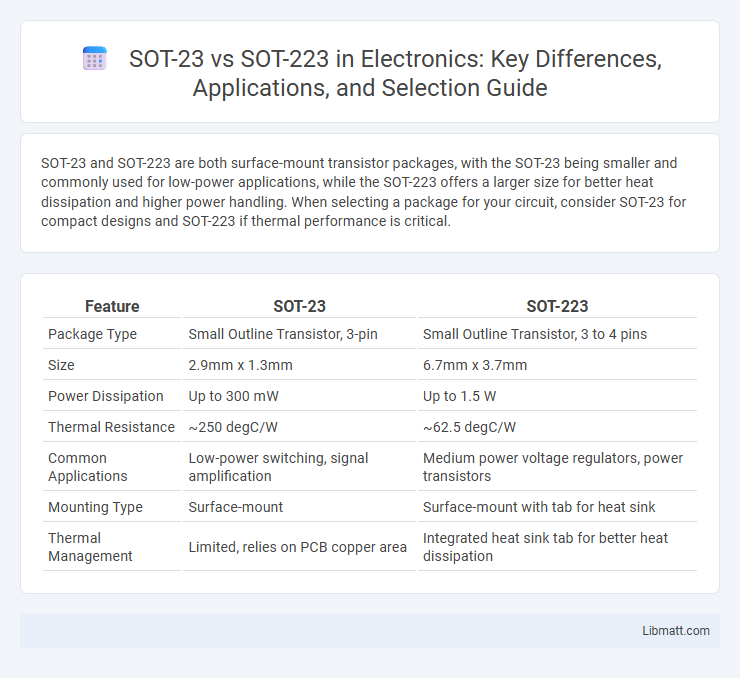SOT-23 and SOT-223 are both surface-mount transistor packages, with the SOT-23 being smaller and commonly used for low-power applications, while the SOT-223 offers a larger size for better heat dissipation and higher power handling. When selecting a package for your circuit, consider SOT-23 for compact designs and SOT-223 if thermal performance is critical.
Table of Comparison
| Feature | SOT-23 | SOT-223 |
|---|---|---|
| Package Type | Small Outline Transistor, 3-pin | Small Outline Transistor, 3 to 4 pins |
| Size | 2.9mm x 1.3mm | 6.7mm x 3.7mm |
| Power Dissipation | Up to 300 mW | Up to 1.5 W |
| Thermal Resistance | ~250 degC/W | ~62.5 degC/W |
| Common Applications | Low-power switching, signal amplification | Medium power voltage regulators, power transistors |
| Mounting Type | Surface-mount | Surface-mount with tab for heat sink |
| Thermal Management | Limited, relies on PCB copper area | Integrated heat sink tab for better heat dissipation |
Introduction to SOT-23 and SOT-223 Packages
SOT-23 and SOT-223 are widely used surface-mount transistor packages designed for different power and size requirements. SOT-23 is a compact package typically housing small-signal transistors and diodes with three leads, favored for space-saving in high-density PCBs. SOT-223, larger in size, supports higher power dissipation with a thermal tab and four leads, commonly used for voltage regulators and power transistors.
Overview of SOT-23 Package
The SOT-23 package is a compact, low-profile surface-mount transistor package widely used for small-signal transistors and diodes in electronic circuits requiring minimal board space. Featuring a three-lead configuration, it offers efficient thermal performance and is favored in portable and high-density applications. Its smaller footprint compared to packages like SOT-223 makes SOT-23 ideal for intricate circuit designs with stringent space constraints.
Overview of SOT-223 Package
The SOT-223 package is a surface-mount transistor outline widely used in power transistors and voltage regulators due to its capability to dissipate higher power compared to SOT-23. Featuring a larger size and a metal tab for heat sinking, the SOT-223 allows for improved thermal performance, making it suitable for medium-power applications typically up to 1-2 watts. Its four-lead design provides better electrical contact and mechanical stability, distinguishing it from the smaller, three-lead SOT-23 package used for low-power devices.
Key Differences Between SOT-23 and SOT-223
SOT-23 and SOT-223 differ primarily in size, power dissipation, and pin configuration, with SOT-223 being larger and capable of handling higher power levels, typically up to 1-3 watts compared to the SOT-23's lower power rating. The SOT-23 package usually features 3 pins, making it ideal for small signal transistors and diodes, while the SOT-223 incorporates 3 to 4 pins with a larger heat sink tab to improve thermal performance. Your choice between the two depends on the application's power requirements and available PCB space, where SOT-23 suits compact designs and SOT-223 fits medium-power applications.
Physical Dimensions and Footprint Comparison
SOT-23 packages typically measure around 2.9 mm x 1.3 mm, offering a smaller footprint ideal for high-density PCB layouts where space savings are critical. In contrast, SOT-223 packages are larger, approximately 6.7 mm x 3.7 mm, providing better thermal dissipation and easier handling for components requiring higher power ratings. Your choice between SOT-23 and SOT-223 depends on balancing compact size with thermal management needs in your electronic designs.
Thermal Performance and Heat Dissipation
The SOT-223 package offers superior thermal performance and heat dissipation compared to the smaller SOT-23, thanks to its larger surface area and integrated metal tab that efficiently transfers heat away from the semiconductor die. You can expect lower junction-to-ambient thermal resistance values in SOT-223, typically around 50degC/W, versus approximately 150degC/W for SOT-23, enabling higher power handling and improved reliability in high-temperature applications. Selecting SOT-223 over SOT-23 is crucial when your design demands enhanced thermal management and prolonged device longevity.
Electrical Characteristics and Ratings
SOT-23 and SOT-223 packages differ significantly in electrical characteristics and ratings, with SOT-223 typically supporting higher power dissipation (up to 3W or more) due to its larger size and improved heat dissipation capabilities. SOT-23 is suited for low-power applications, usually up to 350mW, making it ideal for small-signal transistors and diode circuits. You should consider SOT-223 when your design demands higher current handling and thermal performance to maintain reliability and efficiency.
Typical Applications of SOT-23 vs SOT-223
SOT-23 packages are commonly used for small-signal transistors, diodes, and low-power integrated circuits in portable electronics due to their compact size and minimal footprint. SOT-223 packages are preferred for power transistors, voltage regulators, and power ICs requiring better heat dissipation in applications like power management and automotive electronics. Your choice between SOT-23 and SOT-223 depends on power handling requirements and thermal management constraints.
Considerations for PCB Design
When choosing between SOT-23 and SOT-223 packages for your PCB design, consider the thermal dissipation and footprint size; SOT-23 is compact and ideal for space-constrained layouts but has limited heat dissipation capability. SOT-223 offers better thermal management due to its larger copper pad area, making it suitable for components requiring efficient heat sinking. Your PCB layout should incorporate adequate copper areas and thermal vias to optimize heat transfer for SOT-223, while SOT-23 designs focus more on minimizing parasitic inductance in high-frequency circuits.
Choosing Between SOT-23 and SOT-223
Choosing between SOT-23 and SOT-223 depends on your circuit's power dissipation and space constraints. SOT-23 is ideal for low-power, compact applications due to its smaller footprint and limited heat dissipation capabilities. For higher power devices requiring better thermal management, SOT-223 offers a larger package with enhanced heat sinking, making it suitable when your design demands efficient heat dissipation alongside moderate space usage.
SOT-23 vs SOT-223 Infographic

 libmatt.com
libmatt.com